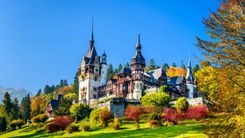To right that wrong, visit Moldova’s most impressive winery, Milestii Mici, which is located a mere 30 minutes’ drive south of Chişinău. With 1.5 million bottles stored in a 55km subterranean labyrinth, it boasts the world’s largest wine collection, as recognised by the Guinness Book of Records. A tour of the winery takes in the tunnels via electric train or bicycles, with the option to eat, drink and make merry in the opulent tasting halls - a glamourous must-do experience for gourmands visiting Moldova.
2. Meander magnificent monasteries
Monastic life thrives across Moldova, meaning that church frescoes are lovingly maintained, tulip gardens immaculately manicured, and silvery domes polished to a shine, and you don’t have to be especially religious-minded to appreciate their beauty and history either.
Capriana Monastery, for example, is among the country’s finest architectural sights. Located 40km northeast of Chişinău, and often called the cradle of Moldovan culture, this complex of three churches surrounded by rolling hills and forests really is a top reason to visit Moldova. Established in 1429, the site’s Church of the Dormition is the country’s oldest church. To sample Moldova’s monastic culture (and wine) in convenient, comfortable style, you could look to book a multi-site tour that combines exploring Capriana Monastery with a visit to Cricova Winery and some of Chişinău’s highlights.
Another must-visit Moldovan marvel comes courtesy of Saharna Monastery. Given its stunning location - encircled by rocky hills and thick forests in a corner of north-eastern Moldova - it’s little wonder that this a popular place of pilgrimage (though we’re not talking Lourdes level visitor numbers). It’s also the perfect spot to enjoy a peaceful woodland walk with waterfalls tinkling in the background. Oh, and history buffs will be keen to explore the Iron Age fortress remains.
3. Explore archeological treasures
After traversing Moldova's tapestry of wildflower meadows and cornfields, the archaeological and ecclesiastical complex of Orheiul Vechi (Old Orhei) is a riveting contrast - a monastery resplendent with golden domes and white bell-towers backed by ashen cliffs. Situated 50km north of Chişinău, Orheiul Vechi is most known for its Cave Monastery - a complex of rooms and tunnels cut into a rocky ridge above the Răut River. But there’s more to this UNESCO World Heritage site than the monastery alone - traces of human life dating back to Paleolithic times have been unearthed here, and it’s been inhabited by hermit monks seeking solitude in its caves since the fourteenth-century.















